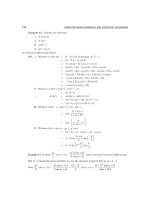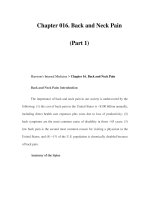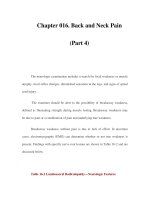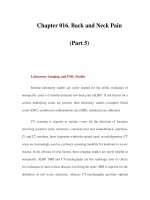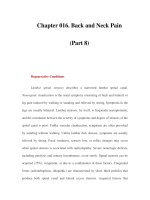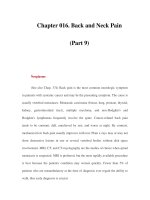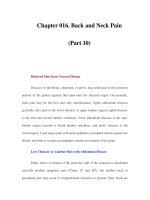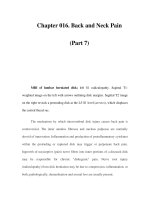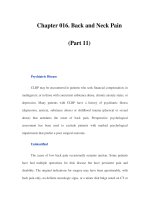Chapter 016. Back and Neck Pain (Part 14) ppsx
Bạn đang xem bản rút gọn của tài liệu. Xem và tải ngay bản đầy đủ của tài liệu tại đây (59.1 KB, 5 trang )
Chapter 016. Back and Neck Pain
(Part 14)
Trauma to the Cervical Spine
Trauma to the cervical spine (fractures, subluxation) places the spinal cord
at risk for compression. Motor vehicle accidents, violent crimes, or falls account
for 87% of spinal cord injuries (Chap. 372). Immediate immobilization of the neck
is essential to minimize further spinal cord injury from movement of unstable
cervical spine segments. A CT scan is the diagnostic procedure of choice for
detection of acute fractures. Following major trauma to the cervical spine, injury
to the vertebral arteries is common; most lesions are asymptomatic and can be
visualized by MRI and angiography.
Whiplash injury is due to trauma (usually automobile accidents) causing
cervical musculoligamental sprain or strain due to hyperflexion or hyperextension.
This diagnosis should not be applied to patients with fractures, disk herniation,
head injury, focal neurologic findings, or altered consciousness. Imaging of the
cervical spine is not cost-effective acutely but is useful to detect disk herniations
when symptoms persist for >6 weeks following the injury. Severe initial
symptoms have been associated with a poor long-term outcome.
Cervical Disk Disease
Herniation of a lower cervical disk is a common cause of neck, shoulder,
arm, or hand pain or tingling. Neck pain, stiffness, and a range of motion limited
by pain are the usual manifestations. A herniated cervical disk is responsible for
~25% of cervical radiculopathies. Extension and lateral rotation of the neck
narrows the ipsilateral intervertebral foramen and may reproduce radicular
symptoms (Spurling's sign). In young persons, acute nerve root compression from
a ruptured cervical disk is often due to trauma. Cervical disk herniations are
usually posterolateral near the lateral recess and intervertebral foramen. Typical
patterns of reflex, sensory, and motor changes that accompany specific cervical
nerve root lesions are summarized in Table 16-4; however, (1) overlap in function
between adjacent nerve roots is common, (2) symptoms and signs may be evident
in only part of the injured nerve root territory, and (3) the location of pain is the
most variable of the clinical features.
Cervical Spondylosis
Osteoarthritis of the cervical spine may produce neck pain that radiates into
the back of the head, shoulders, or arms, or may be the source of headaches in the
posterior occipital region (supplied by the C2-C4 nerve roots). Osteophytes, disk
protrusions, and hypertrophic facet or uncovertebral joints may compress one or
several nerve roots at the intervertebral foramina (Fig. 16-7); this compression
accounts for 75% of cervical radiculopathies. The roots most commonly affected
are C7 and C6. Narrowing of the spinal canal by osteophytes, ossification of the
posterior longitudinal ligament (OPLL), or a large central disk may compress the
cervical spinal cord. Combinations of radiculopathy and myelopathy may also be
present. Spinal cord involvement is suggested by Lhermitt's symptom, an electrical
sensation elicited by neck flexion and radiating down the spine from the neck.
When little or no neck pain accompanies cord compression, the diagnosis may be
confused with amyotrophic lateral sclerosis (Chap. 369), multiple sclerosis (Chap.
375), spinal cord tumors, or syringomyelia (Chap. 372). The possibility of cervical
spondylosis should be considered even when the patient presents with symptoms
or signs in the legs only. MRI is the study of choice to define the anatomic
abnormalities, but plain CT is adequate to assess bony spurs, foraminal narrowing,
or OPLL. EMG and nerve conduction studies can localize and assess the severity
of the nerve root injury.
Figure 16-7
Cervical spondylosis; left C6 radiculopathy. A. Sagittal T2 fast spin echo
magnetic resonance imaging reveals a hypointense osteophyte that protrudes from
the C5-C6 level into the thecal sac, displacing the spinal cord posteriorly (white
arrow). B. Axial 2-mm section from a 3-D volume gradient echo sequence of the
cervical spine. The high signal of the right C5-C6 intervertebral foramen contrasts
with the narrow high signal of the left C5-C6 intervertebral foramen produced by
osteophytic spurring (arrows).
